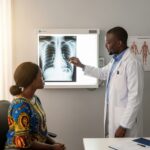Throughout the first week of August 2025, the Africa Centres for Disease Control and Prevention (Africa CDC) maintained a steadfast watch over the continent’s evolving infectious disease landscape. Driven by the imperative to detect threats early and coordinate robust public health interventions, Africa CDC’s surveillance network consolidated reports from Member States, laboratory partners, and field teams. This integrated approach ensured that emerging outbreaks were identified within critical timeframes, enabling resources to be mobilized swiftly and cross-border transmission chains to be interrupted before they could widen into regional crises.
Measles reemerged as a significant concern in several West African nations, where routine immunization gaps widened the susceptible population. In Ghana, surveillance officers detected a resurgence of cases in the Northern Region, registering 1,820 suspected measles incidents between 1 and 7 August, of which 210 were laboratory‐confirmed. Although the case fatality ratio remained relatively low at 0.4 percent, the sheer volume of infections hinted at the urgency of closing immunization lapses. As Dr. John Nkengasong, Director of Africa CDC, emphasized, “Every unvaccinated child represents a potential node of transmission that can fuel larger clusters and overwhelm fragile health systems”.
Meanwhile, the cholera outbreak in southern Mozambique persisted, with southern provinces reporting 428 suspected cholera cases and 16 fatalities in the latest week. The case fatality rate of 3.7 percent highlighted gaps in water and sanitation infrastructure that hamper rapid containment efforts. Africa CDC coordinated with the Ministry of Health of Mozambique and international partners to deliver 50,000 oral rehydration salts packets and 12,000 doses of cholera conjugate vaccine to high‐risk districts. This response, characterized in official briefings as “a concerted push to bridge supply chain bottlenecks,” aimed to halt the outbreak’s expansion into neighboring Malawi and Zimbabwe.
In Central Africa, Cameroon notified Africa CDC of an upsurge in monkeypox notifications that saw 47 suspected cases and 14 laboratory confirmations in the past seven days. Ongoing genetic sequencing revealed that the responsible clade aligned with West African variants, which are associated with lower mortality rates but can spread steadily through close contact. Field epidemiologists deployed to Yaoundé

conducted rapid contact tracing exercises, offering ring vaccination to high‐risk contacts and engaging community leaders to dispel misconceptions about transmission pathways. “Our success hinges on community trust, which we build through transparency, local ownership, and culturally sensitive risk communication,” remarked Dr. Ahmed Ogwell Ouma, Acting Director of Africa CDC, during a regional coordination meeting.
Uganda’s fledgling yellow fever cluster in the western districts prompted an immediate surge in entomological surveys and vector control operations. The Ministry of Health reported 15 suspected yellow fever cases, of which five were confirmed by the National Virus Reference Laboratory in Entebbe. With Aedes aegypti mosquito densities exceeding epidemic thresholds in several rural communities, Uganda’s response deployed ten mobile vaccination teams, which successfully reached 8,300 individuals in under five days. Africa CDC’s logistics unit facilitated the rapid shipment of 100,000 doses of yellow fever vaccine from the African Vaccine Acquisition Trust stockpile, underscoring the collaborative mechanisms now embedded within the continent’s epidemic preparedness framework.
COVID-19 activity across Africa stabilized at a lower endemic baseline, with 35,400 new cases and 220 deaths reported for the week. South Africa, Nigeria, and Egypt continued to represent the bulk of notifications, though hospitalization rates remained well below peaks seen in prior years. Africa CDC’s genomic surveillance network identified no novel variants of concern, offering cautious reassurance that the current virological landscape is unlikely to precipitate renewed waves of severe disease—provided vaccination coverage and nonpharmaceutical measures are maintained in high‐risk settings such as care homes and mass gatherings.

The weekly report also highlighted an emerging surge of respiratory syncytial virus (RSV) in Eastern Africa, especially among infants under two years of age. Hospitals in Kenya and Tanzania reported doubling rates of acute lower respiratory tract infections compared to the same period in 2024. Though RSV carries a high hospitalization burden, Africa CDC’s coordination with the Africa Union Development Agency–NEPAD
enabled expedited access to RSV monoclonal antibody prophylaxis for the most vulnerable newborn cohorts, marking a significant stride in equitable treatment access across the continent. Amid these overlapping health events, Africa CDC underscored the indispensable role of real‐time data sharing and interagency collaboration. “We have moved beyond siloed responses. Today, timely intelligence synthesis, combined with agile financing and logistics, empowers Member States to mount interventions tailored to local realities,” the weekly narrative stated. This refrain resonated throughout the report, showcasing how the Africa CDC network, in concert with the World Health Organization and bilateral partners, is weaving a robust epidemiological safety net.
Sustained support from partners, including the Bill & Melinda Gates Foundation and PEPFAR, continues to fortify Africa CDC’s operational capabilities. In particular, advancements in mobile data collection platforms have reduced reporting delays from an average of seven days to under 48 hours, dramatically enhancing the speed of decision making at both national emergency operations centres and community health teams.
Looking ahead, Africa CDC’s Senior Leadership have called for renewed investments in laboratory networks, community health workforce training, and risk communication frameworks. By strengthening the foundational pillars of surveillance, laboratory diagnostics, and outbreak response, the continent aims to preemptively quell the next threat on the horizon. As Niger’s Health Minister Sarah Issaka remarked during the virtual Ministerial Briefing, “Our collective vigilance today is our shield against tomorrow’s unknowns.”
Source: Africa_CDC_Weely_Epidemic_Intelligence__Report_10_Aug_25.pdf



